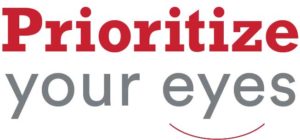Sponsored content
April 21, 2020
By Carol Alexander, OD, FAAO
Head, North America Professional Relations, Johnson & Johnson Vision
 It’s hard to imagine that less than two months ago, Johnson & Johnson Vision launched Prioritize Your Eyes—a worldwide effort to raise awareness about the connection of eye health to overall health that encouraged everyone to take the single most important step in eye health—get an eye exam.
It’s hard to imagine that less than two months ago, Johnson & Johnson Vision launched Prioritize Your Eyes—a worldwide effort to raise awareness about the connection of eye health to overall health that encouraged everyone to take the single most important step in eye health—get an eye exam.
The world looks so different now than it did then. As the COVID-19 pandemic spread quickly, so did the change in the world’s priorities, including ours. And while the ways in which we work to improve the trajectory of eye health worldwide evolve, our vision remains steadfast: to help people see better, connect better, live better.
We know the economic impact to the eyecare industry is profound, with projections that the American eyecare business as a whole might be losing up to $1.7B each month while1 the world is in relative shut down. Johnson & Johnson Vision is ensuring customer service support and professional education remain fully accessible, and we’re vigilantly monitoring supply chain continuity.
Throughout this situation, though, I keep trying to find the silver linings. Perhaps this time without patients is a moment to reflect on practice strengths and the value your patients place on their relationship with you and your staff; perhaps the crisis helps practitioners think forward and envision a future with telehealth technologies; or maybe it’s a time to increase one’s understanding of Myopia overall (progress, treatment options, etc.), how it can fit within the practice and serve as a growth opportunity and valued offering for patients when we return to life post-COVID-19.
Even though getting an eye exam isn’t in the cards right now, Johnson & Johnson Vision continues to support eye care professionals. While social distancing keeps us apart, we continue to share information with consumers and our employees that there are still many ways you can Prioritize Your Eyes while at home, including:
- As screen time has grown dramatically2 since the pandemic began, make sure you’re giving your eyes a rest with the 20-20-20 rule: every 20 minutes, make sure to look at least 20 feet away for 20 seconds, which gives your eyes a chance to recover in between binging on the latest TV series.
- When your eyes are fixated on a screen, you subconsciously blink less because of the amount of focus you’re using.3 Each time you get up to use the restroom or grab a snack, try to do five complete blinks to remoisten your eyes. Complete blinking is important to activate your oil glands in your lids and to spread these beneficial oils—and your protective tear film layer—across your eyes.4
- Meal plan with your eyes in mind. A diet full of omega-3 fatty acids (use up that canned tuna!), leafy greens, and Vitamin A (e.g. carrots) can give your eyes the nutrients they need to stay strong.5,6 These foods also contain more antioxidant vitamins such as C and E, which may help protect the eyes against cataracts and age-related macular degeneration as well.7,8
Advice for those who have children at home—now might be a good time to use the new role of stay-at-home teacher to educate the kids about the importance of eye health as well! Implement and model good behavior for them—when you can—such as going outside9 and trying to limit time on digital devices.10 All these things can aid in preventing the development and/or progression of Myopia.
Even though people can’t go get a routine eye exam right now, use this opportunity—and the resources available on the Johnson & Johnson Vision website and social channels—to teach children that their annual eye exam is incredibly important to their overall health—it can help detect more than 270 different diseases!11 Parents can be on the lookout for any potential visual symptoms and make sure to get routine eye appointments back on the calendar whenever life gets ‘back to normal.’ We’re proud to include a find a doctor in your area link here that also has additional resources.
Johnson & Johnson Vision is preparing for what that “new normal” may look like and is hosting several webinars for optometrists on considerations and how to prepare for post-COVID 19. The next webinar is taking place on Wednesday, April 29 from 4-5 p.m. EST, entitled “The New Normal for Optometry – the Future of Eye Care Post COVID-19” and will be led by Dr. Chandra Mickles, who will discuss potential changes from caring for patients to running a practice.
At Johnson & Johnson, we believe good health is the foundation of vibrant lives, thriving communities, and forward progress—that remains true in the time of COVID-19 but also as we look ahead. You can learn more about our response to this crisis here. As the tide starts to turn and we emerge from our ‘new normal,’ the awareness of both global health and our personal health will be even more heightened.
Even if you’re stuck at home right now, there’s never been a better time to Prioritize Your Eyes. And you should know we continue to promote the message that your eye health is a crucial part of your overall health, and your health should be coming first these days. Now, take 20 seconds to stare off into the distance and have a nice blink.
REFERENCES
- Economic Impact to Eyecare Industry. Save 2020 Eyecare. March 2020. American Optometric Association; Bureau of Labor Statistics; The Vision Council, Vision Watch 2019; Management Business Academy 2019.
- Nielsen Explains How COVID-19 Could Impact Media Usage Across the US. Tech Crunch. https://techcrunch.com/2020/03/17/nielsen-explains-how-covid-19-could-impact-media-usage-across-the-u-s/. March 2020.
- All About Vision. Can You Get Dry Eyes From Using A Computer Or Watching TV? https://www.allaboutvision.com/conditions/dry-eyes-faq/dry-eyes-from-computer.htm. April 2020.
- Wang, Michael T.m., et al. Impact of Blinking on Ocular Surface and Tear Film Parameters. The Ocular Surface, 2018 Oct; 16(4): 424–429.
- All About Vision. Eye benefits of omega-3 fatty acids. https://www.allaboutvision.com/nutrition/fatty_acid_1.htm. April 2020.
- All About Vision. Eye benefits of vitamin A and beta-carotene. https://www.allaboutvision.com/nutrition/vitamin_a.htm. April 2020.
- American Optometric Association. Vitamin C may slow progress of cataracts. https://www.aoa.org/news/clinical-eye-care/vitamin-c-may-slow-progress-of-cataracts. April 2020.
- American Optometric Association. Vitamin E. https://www.aoa.org/patients-and-public/caring-for-your-vision/diet-and-nutrition/vitamin-e. April 2020.
- American Academy of Ophthalmology. Outdoor Activity and Myopia Progression in Children. https://www.aao.org/eyenet/article/outdoor-activity-and-myopia-in-children. August 2018.
- American Academy of Ophthalmology. Is Too Much Screen Time Harming Children’s Vision? https://www.aao.org/newsroom/news-releases/detail/is-too-much-screen-time-harming-childrens-vision. August 2018.
- Systemic Conditions with Ocular and Visual Manifestations. American Optometric Association. https://www.aoa.org/assets/documents/EBO/Systemic-Conditions-Ocular-Visual-Manifestations.pdf. December 2019.













